Abstract
Genetic recombination in bacteriophage φX174 usually takes place early in the infection process and involves two parental replicative form (double-stranded) DNA molecules. The host recA protein is required; none of the nine known φX174 cistron products is essential. The products of a single recombination event are nonreciprocal and asymmetric. Typically, only one of the parental genotypes and one recombinant genotype are recovered from a single cell. An alternative, less efficient recombination mechanism which requires an active φX174 cistron A protein is observed in the absence of the host recA gene product.
Full text
PDF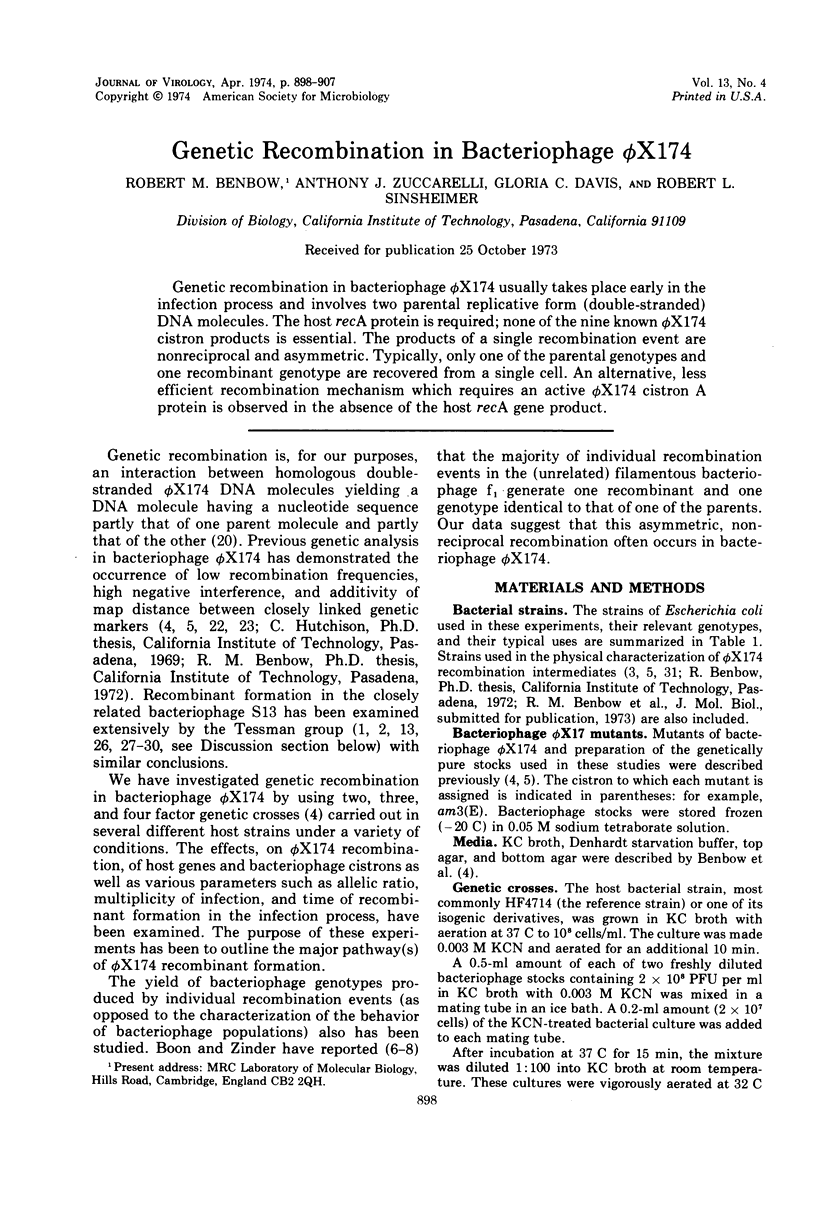
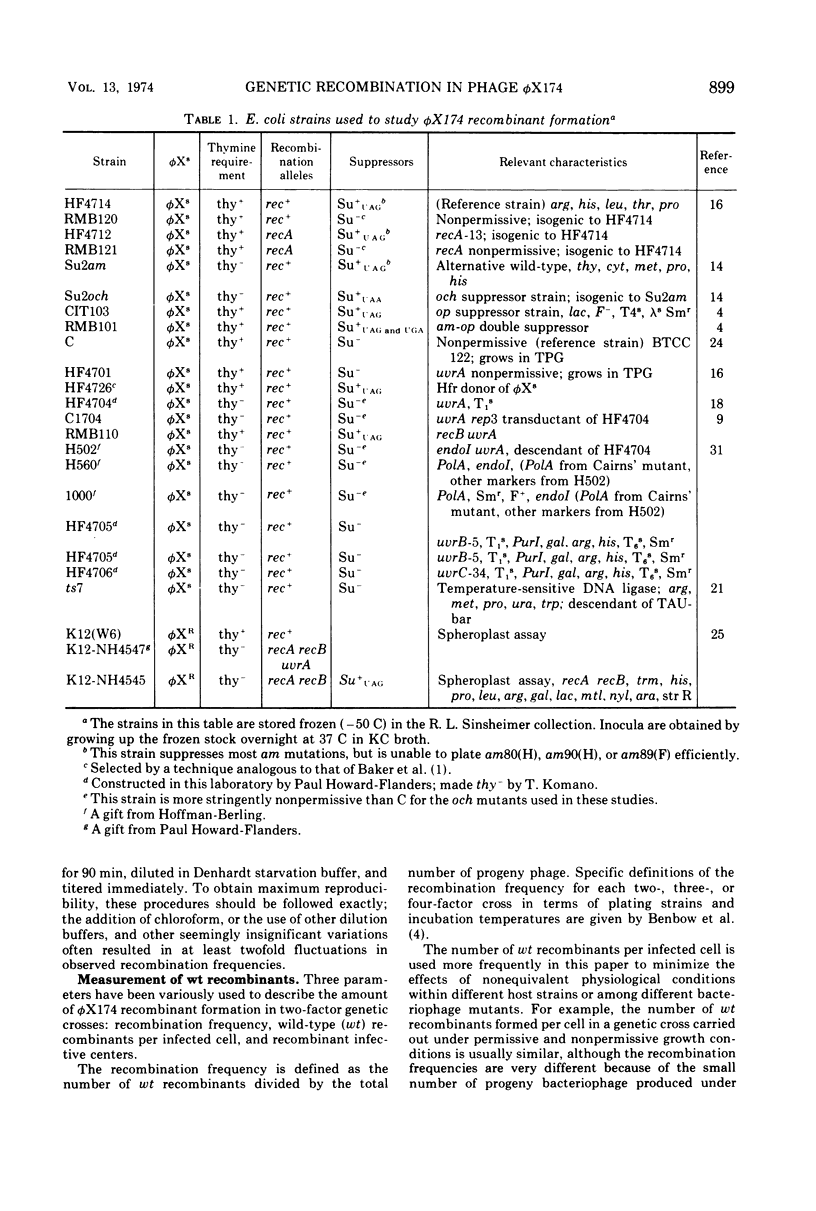
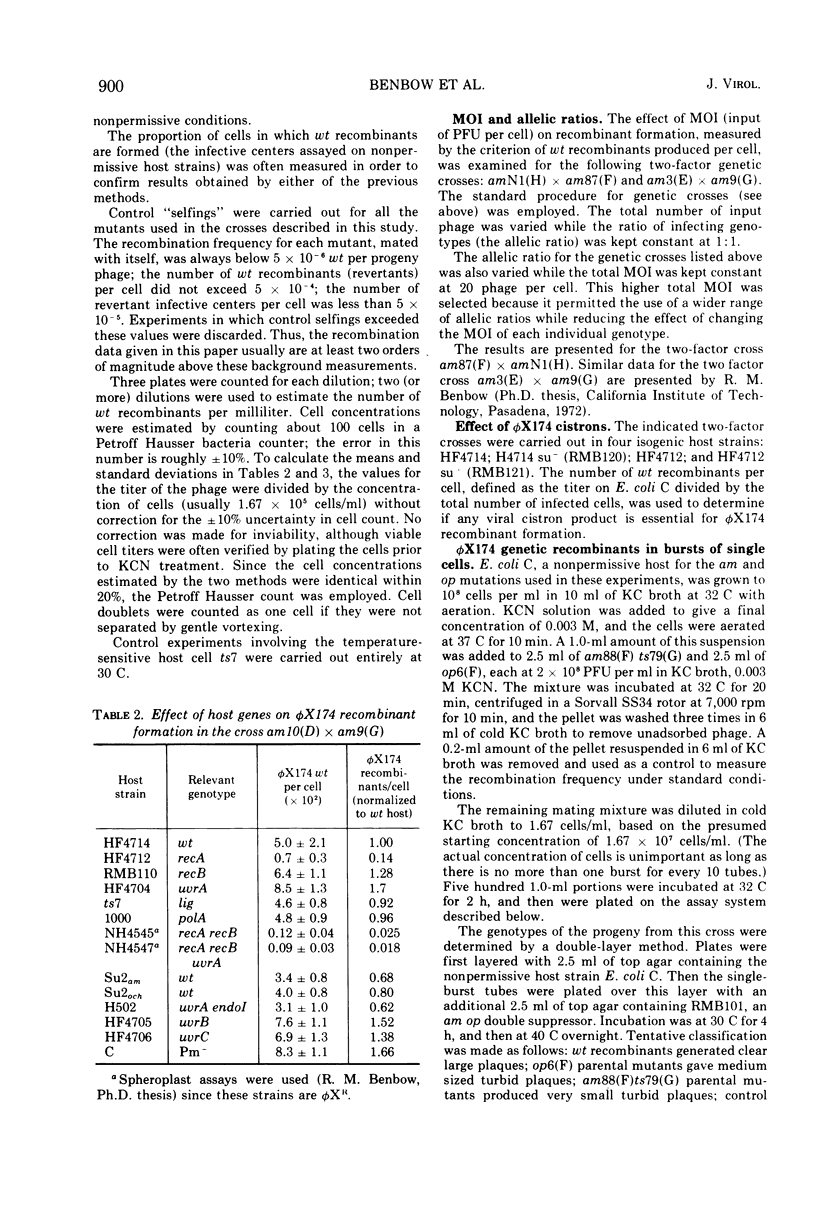
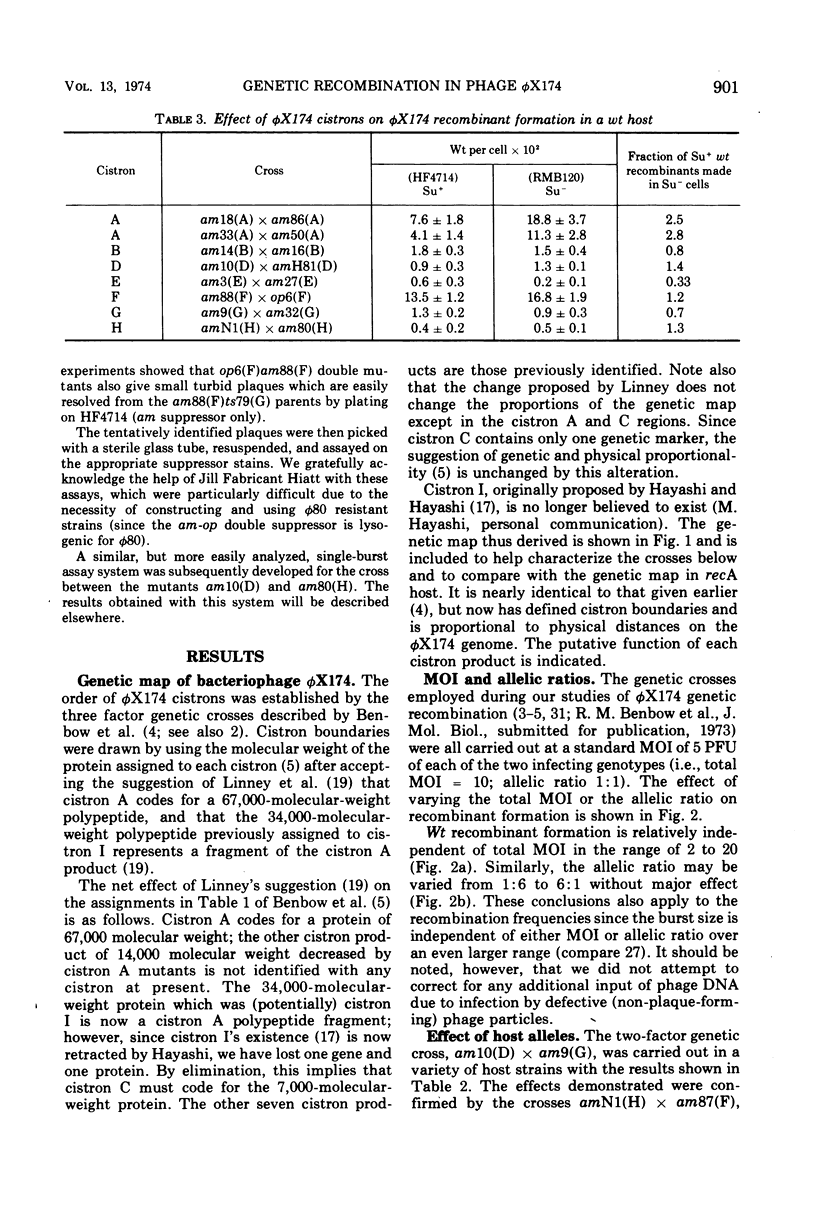
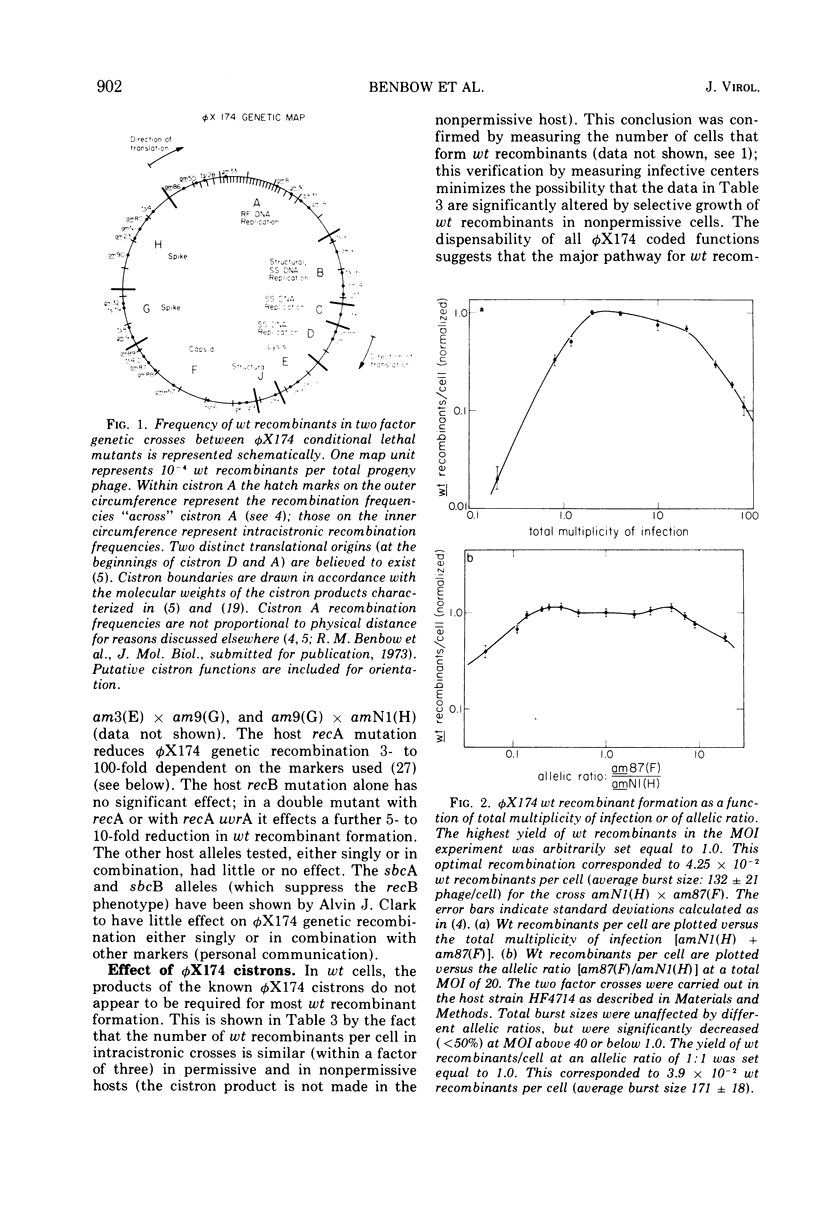
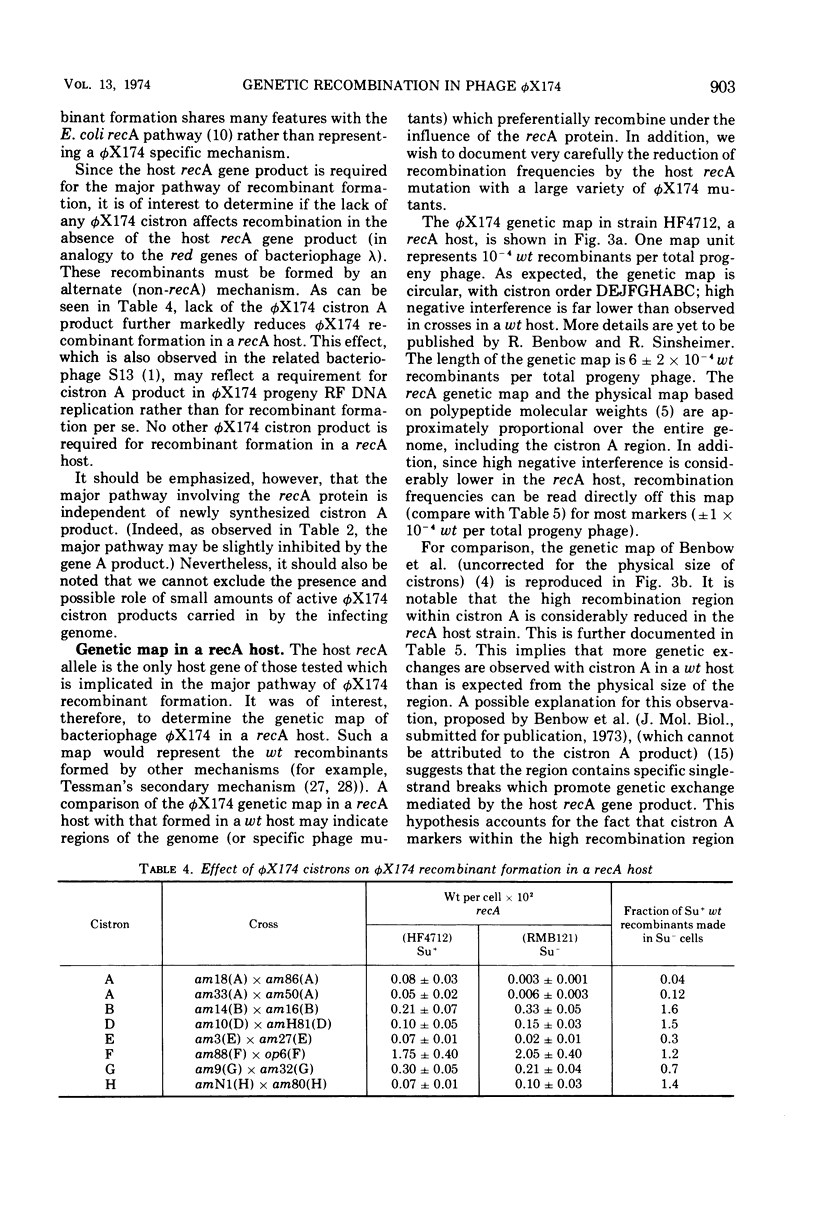
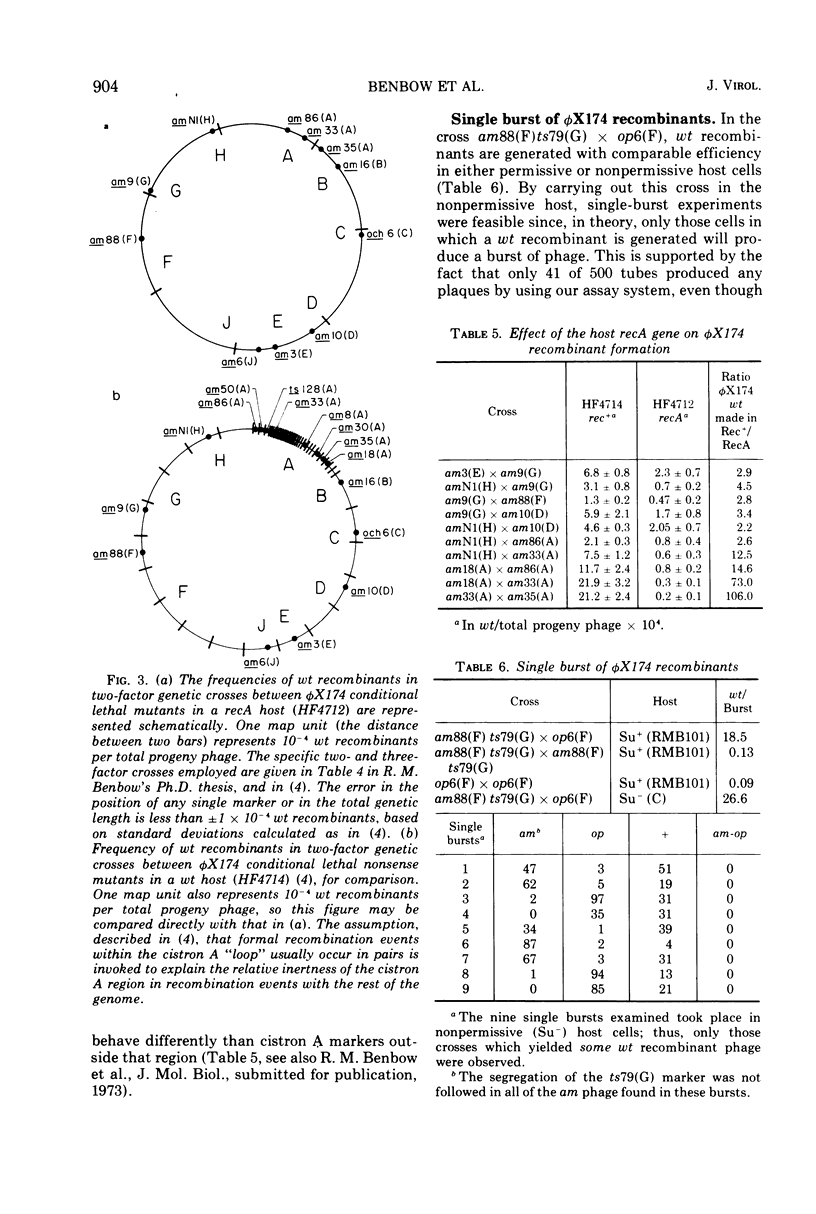
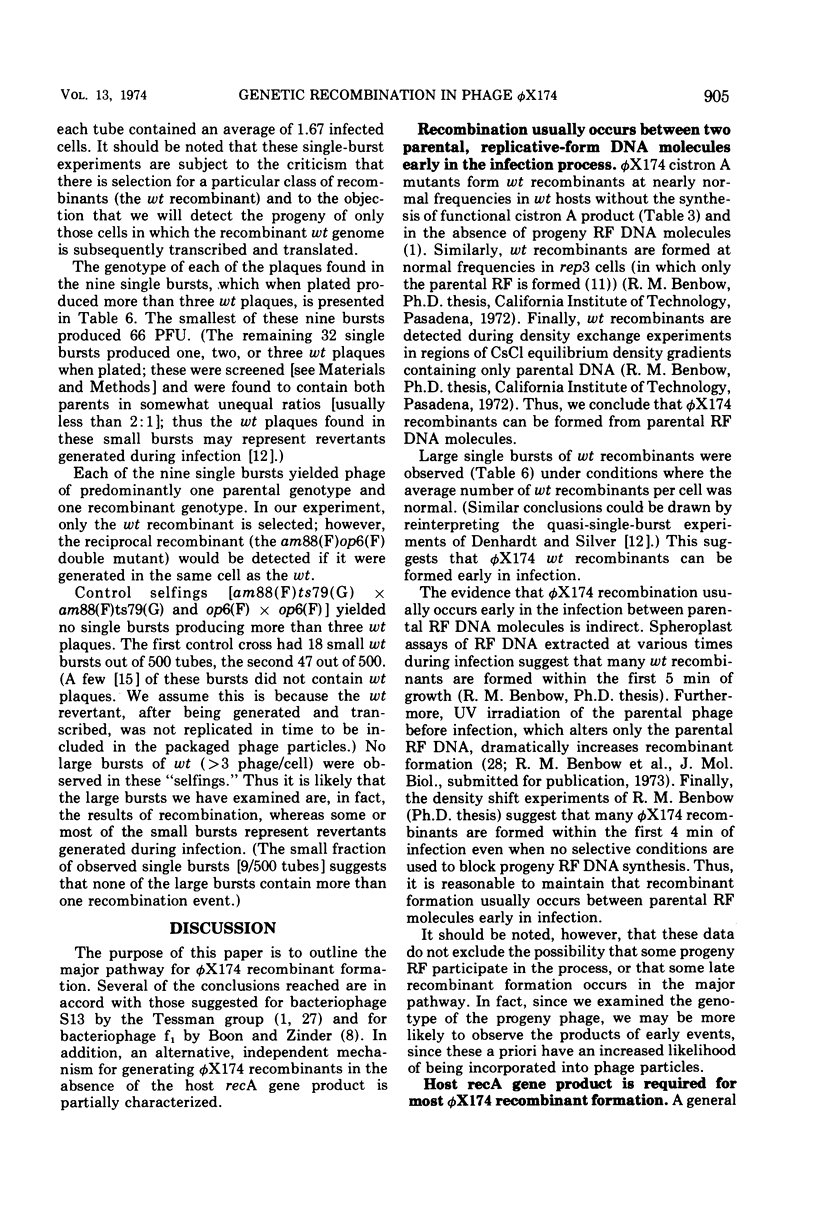
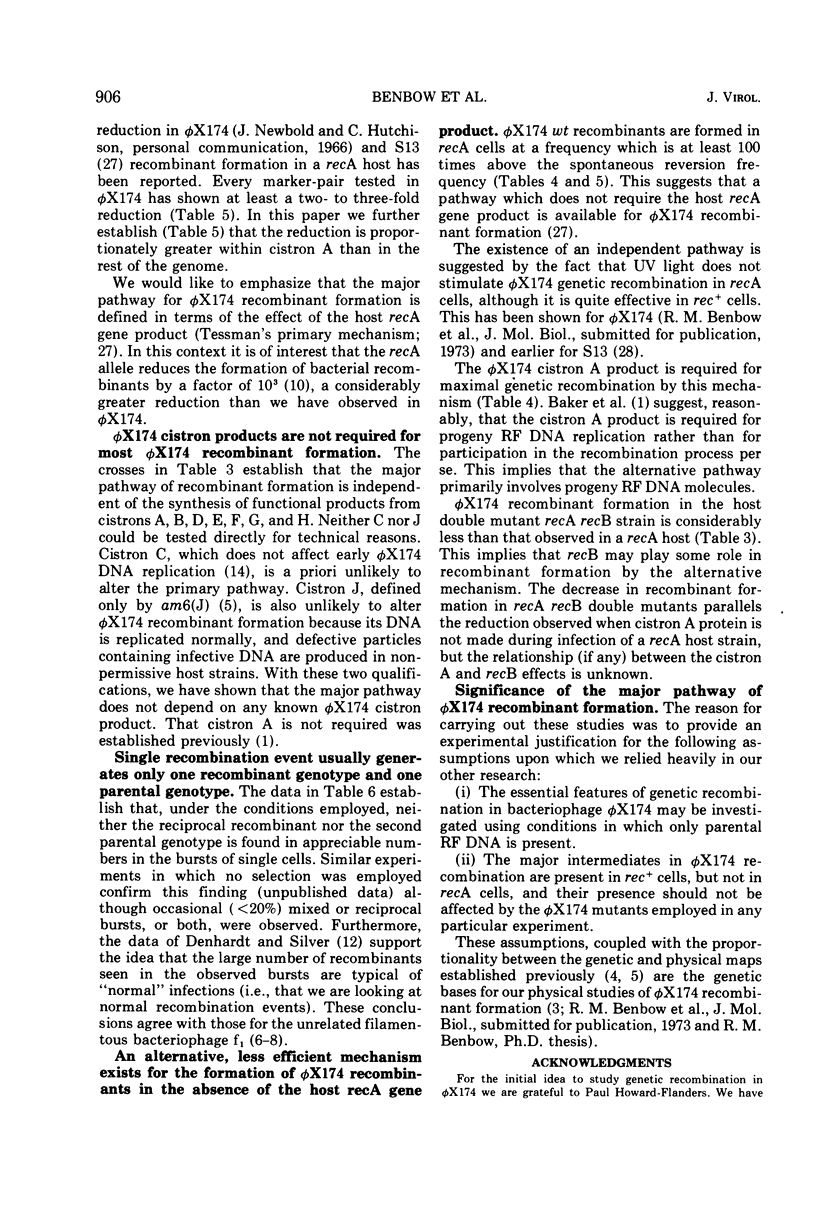
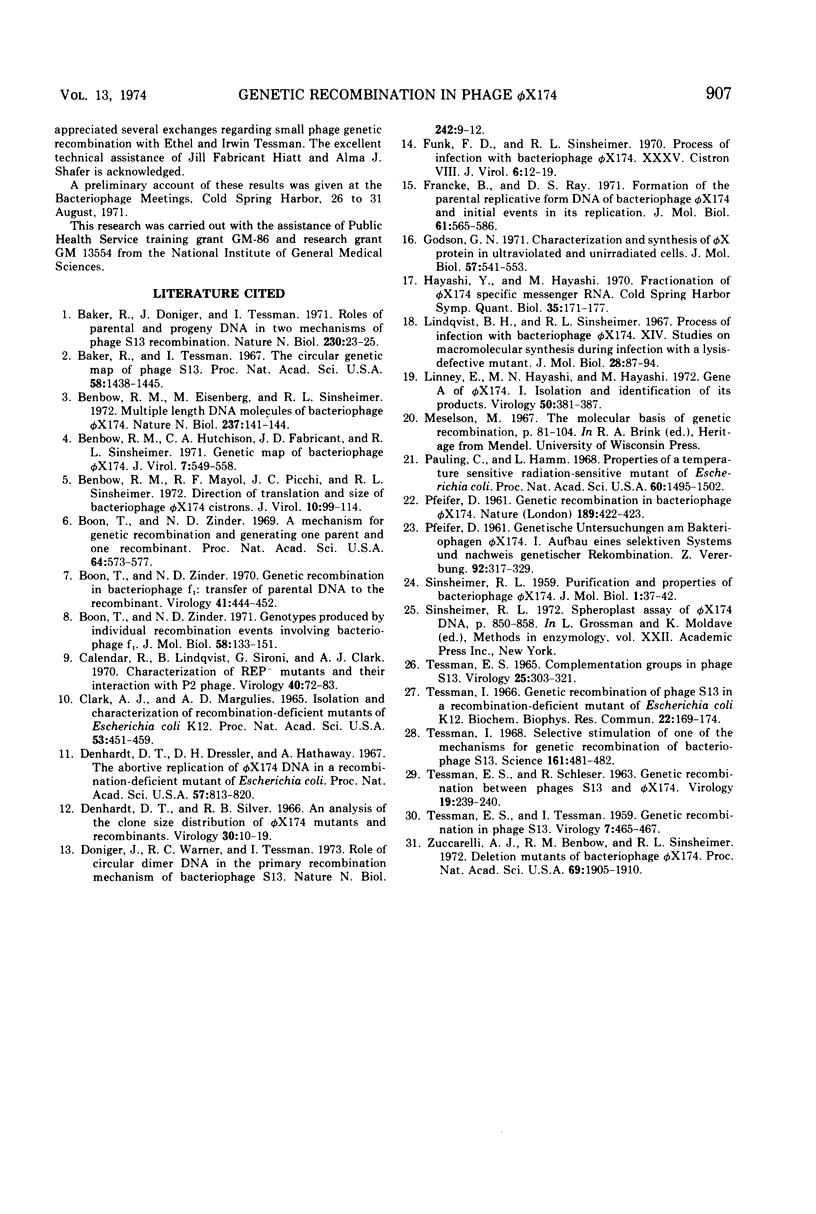
Selected References
These references are in PubMed. This may not be the complete list of references from this article.
- Baker R., Doniger J., Tessman I. Roles of parental and progeny DNA in 2 mechanisms of phage S13 recombination. Nat New Biol. 1971 Mar 3;230(1):23–25. doi: 10.1038/newbio230023a0. [DOI] [PubMed] [Google Scholar]
- Baker R., Tessman I. The circular genetic map of phage S13. Proc Natl Acad Sci U S A. 1967 Oct;58(4):1438–1445. doi: 10.1073/pnas.58.4.1438. [DOI] [PMC free article] [PubMed] [Google Scholar]
- Benbow R. M., Eisenberg M., Sinsheimer R. L. Multiple length DNA molecules of bacteriophage phi-X174. Nat New Biol. 1972 May 31;237(74):141–144. doi: 10.1038/newbio237141a0. [DOI] [PubMed] [Google Scholar]
- Benbow R. M., Hutchison C. A., Fabricant J. D., Sinsheimer R. L. Genetic Map of Bacteriophage phiX174. J Virol. 1971 May;7(5):549–558. doi: 10.1128/jvi.7.5.549-558.1971. [DOI] [PMC free article] [PubMed] [Google Scholar]
- Benbow R. M., Mayol R. F., Picchi J. C., Sinsheimer R. L. Direction of Translation and Size of Bacteriophage phiX174 Cistrons. J Virol. 1972 Jul;10(1):99–114. doi: 10.1128/jvi.10.1.99-114.1972. [DOI] [PMC free article] [PubMed] [Google Scholar]
- Boon T., Zinder N. D. A mechanism for genetic recombination generating one parent and one recombinant. Proc Natl Acad Sci U S A. 1969 Oct;64(2):573–577. doi: 10.1073/pnas.64.2.573. [DOI] [PMC free article] [PubMed] [Google Scholar]
- Boon T., Zinder N. D. Genetic recombination in bacteriophage f1: transfer of parental DNA to the recombinant. Virology. 1970 Jul;41(3):444–452. doi: 10.1016/0042-6822(70)90165-0. [DOI] [PubMed] [Google Scholar]
- Boon T., Zinder N. D. Genotypes produced by individual recombination events involving bacteriophage f1. J Mol Biol. 1971 May 28;58(1):133–151. doi: 10.1016/0022-2836(71)90237-3. [DOI] [PubMed] [Google Scholar]
- CLARK A. J., MARGULIES A. D. ISOLATION AND CHARACTERIZATION OF RECOMBINATION-DEFICIENT MUTANTS OF ESCHERICHIA COLI K12. Proc Natl Acad Sci U S A. 1965 Feb;53:451–459. doi: 10.1073/pnas.53.2.451. [DOI] [PMC free article] [PubMed] [Google Scholar]
- Calendar R., Lindqvist B., Sironi G., Clark A. J. Characterization of REP- mutants and their interaction with P2 phage. Virology. 1970 Jan;40(1):72–83. doi: 10.1016/0042-6822(70)90380-6. [DOI] [PubMed] [Google Scholar]
- Denhardt D. T., Dressler D. H., Hathaway A. THE ABORTIVE REPLICATION OF PhiX174 DNA IN A RECOMBINATION-DEFICIENT MUTANT OF Escherichia coli. Proc Natl Acad Sci U S A. 1967 Mar;57(3):813–820. doi: 10.1073/pnas.57.3.813. [DOI] [PMC free article] [PubMed] [Google Scholar]
- Denhardt D. T., Silver R. B. An analysis of the clone size distribution of phi-X-174 mutants and recombinants. Virology. 1966 Sep;30(1):10–19. doi: 10.1016/s0042-6822(66)81004-8. [DOI] [PubMed] [Google Scholar]
- Doniger J., Warner R. C., Tessma I. Role of circular dimer DNA in the primary recombination mechanism of bacteriophage S13. Nat New Biol. 1973 Mar 7;242(114):9–12. doi: 10.1038/newbio242009a0. [DOI] [PubMed] [Google Scholar]
- Francke B., Ray D. S. Formation of the parental replicative form DNA of bacteriophage phi-X174 and initial events in its replication. J Mol Biol. 1971 Nov 14;61(3):565–586. doi: 10.1016/0022-2836(71)90065-9. [DOI] [PubMed] [Google Scholar]
- Funk F. D., Sinsheimer R. L. Process of infection with bacteriophage phiX174. XXXV. Cistron 8. J Virol. 1970 Jul;6(1):12–19. doi: 10.1128/jvi.6.1.12-19.1970. [DOI] [PMC free article] [PubMed] [Google Scholar]
- Godson G. N. Characterization and synthesis of phi X174 proteins in ultraviolet-irradiated and unirradiated cells. J Mol Biol. 1971 May 14;57(3):541–553. doi: 10.1016/0022-2836(71)90108-2. [DOI] [PubMed] [Google Scholar]
- Lindqvist B. H., Sinsheimer R. L. Process of infection with bacteriophage phi-X174. XIV. Studies on macromolecular synthesis during infection with a lysis-defective mutant. J Mol Biol. 1967 Aug 28;28(1):87–94. doi: 10.1016/s0022-2836(67)80079-2. [DOI] [PubMed] [Google Scholar]
- Linney E. A., Hayashi M. N., Hayashi M. Gene A of X174. 1. Isolation and identification of its products. Virology. 1972 Nov;50(2):381–387. doi: 10.1016/0042-6822(72)90389-3. [DOI] [PubMed] [Google Scholar]
- PFEIFER D. Genetic recombination in bacteriophage phi-X 174. Nature. 1961 Feb 4;189:422–423. doi: 10.1038/189422a0. [DOI] [PubMed] [Google Scholar]
- PFEIFER D. [Genetic studies on the bacteriophage phi-X174. I. Development of a selective system and demonstration of a genetic recombination]. Z Vererbungsl. 1961;92:317–329. [PubMed] [Google Scholar]
- Pauling C., Hamm L. Properties of a temperature-sensitive radiation-sensitive mutant of Escherichia coli. Proc Natl Acad Sci U S A. 1968 Aug;60(4):1495–1502. doi: 10.1073/pnas.60.4.1495. [DOI] [PMC free article] [PubMed] [Google Scholar]
- TESSMAN E. S. COMPLEMENTATION GROUPS IN PHAGE S13. Virology. 1965 Feb;25:303–321. doi: 10.1016/0042-6822(65)90208-4. [DOI] [PubMed] [Google Scholar]
- TESSMAN E. S., SHLESER R. Genetic recombination between phages S13 and phi-X174. Virology. 1963 Feb;19:239–240. doi: 10.1016/0042-6822(63)90015-1. [DOI] [PubMed] [Google Scholar]
- TESSMAN E. S., TESSMAN I. Genetic recombination in phage S13. Virology. 1959 Apr;7(4):465–467. doi: 10.1016/0042-6822(59)90075-3. [DOI] [PubMed] [Google Scholar]
- Tessman I. Genetic recombination of phage S13 in a recombination-deficient mutant of Escherichia coli K12. Biochem Biophys Res Commun. 1966 Jan 24;22(2):169–174. doi: 10.1016/0006-291x(66)90427-x. [DOI] [PubMed] [Google Scholar]
- Tessman I. Selective stimulation of one of the mechanisms for genetic recombination of bacteriophage S13. Science. 1968 Aug 2;161(3840):481–482. doi: 10.1126/science.161.3840.481. [DOI] [PubMed] [Google Scholar]
- Zuccarelli A. J., Benbow R. M., Sinsheimer R. L. Deletion mutants of bacteriophage phiX174. Proc Natl Acad Sci U S A. 1972 Jul;69(7):1905–1910. doi: 10.1073/pnas.69.7.1905. [DOI] [PMC free article] [PubMed] [Google Scholar]


